In the letters with which Leonardo da Vinci (Vinci, 1452 - Amboise, 1519) presented himself between 1482 and 1485 to the regent of the duchy of Milan, Ludovico il Moro (Milan, 1452 - Loches, 1508), we also read a passage (we see it in folio 1082 of the Codex Atlanticus) in which the artist declares himself capable of “giving work to the bronze horse that will be immortal glory et aetterno honore de la felice memoria del signor vostro patre et de la inclita Casa Sforzesca.” Ludovico’s older brother, Galeazzo Maria Sforza (Fermo, 1444 - Milan, 1476), duke between 1466 and 1476, had in fact been chasing the dream of having an equestrian monument erected to his and Ludovico’s father, Francesco Sforza (Cigoli, 1401 - Milan, 1466), the first Sforza duke of Milan, since 1473, but for ten years nothing came of it: Leonardo was evidently aware of the project and thought of proposing to the Moor, also counting on his provenance. In fact, his master, Verrocchio, had begun, in 1480, the realization of the monument to Bartolomeo Colleoni, which would finally be erected in 1488 in Venice: given his credentials, we can therefore assume that it was not difficult for Leonardo to have the work commissioned by the Moor.
We do not know the exact year in which the regent entrusted Leonardo with the work, but it is certain that the commission dated back to before 1489: in fact, the first known studies of the work date back to this date, and Leonardo worked on it until 1499, the date of the fall of the Sforza family and his move to Florence. There are two moments in the history of the equestrian monument to Francesco Sforza, corresponding to the two distinct projects carried out by the artist. The first probably dates from the period 1485-1490: we do not have the final sketch, but we do have some drawings that help us understand what the monument was to look like when completed. In particular, there is a non-final study preserved at the Royal Collection in Windsor from which we can infer Leonardo’s idea: a prancing horse, that is, rearing on its hind legs, with, in the saddle, the figure of the duke. There was, however, a considerable problem of statics, which Leonardo solved by thinking of unloading the weight of the front part of the horse onto a scenic element: a soldier lying on the ground, on which the horse would rest.
The artist had also thought about the technique of casting the work in bronze: we get news about this from another paper in the Royal Collection where, writes scholar Andrea Bernardoni, “we learn how Leonardo had already matured the idea of casting the monument with a multiple-furnace system with the shape of the horse placed vertically but upside down inside the casting pit. Also in the same paper, on the lower left, we find a drawing of the horse seen in section in which the centina around which the internal supporting structure of the statue is built is highlighted. The morphology and posture of the horse in this drawing deviate from the sketches of the monument and seem to recall a study dated some ten years earlier that presents a very slender prancing horse, as if about to take a leap, which has been interpreted as a study of ancient monuments, seeing its probable source in the colossi of Monte Cavallo in Rome.” However, Leonardo soon abandoned the idea of a monument with a prancing horse, almost certainly because of the thorny problems of a static nature, but also for technical reasons (the State Archives of Florence preserve a letter in which Ludovico il Moro wrote to Lorenzo il Magnifico to ask him to send, from Florence to Milan, two foundrymen because the artist from Vinci did not consider himself capable of completing the project). It would be a long time before we would see the first equestrian monument in history with a prancing horse: succeeding in the feat was Carrarese sculptor Pietro Tacca (Carrara, 1577 - Florence, 1640), who in 1642 finished the casting of the monument to Philip IV of Spain (now in Madrid’s plaza de Oriente), after working on it for eight years.
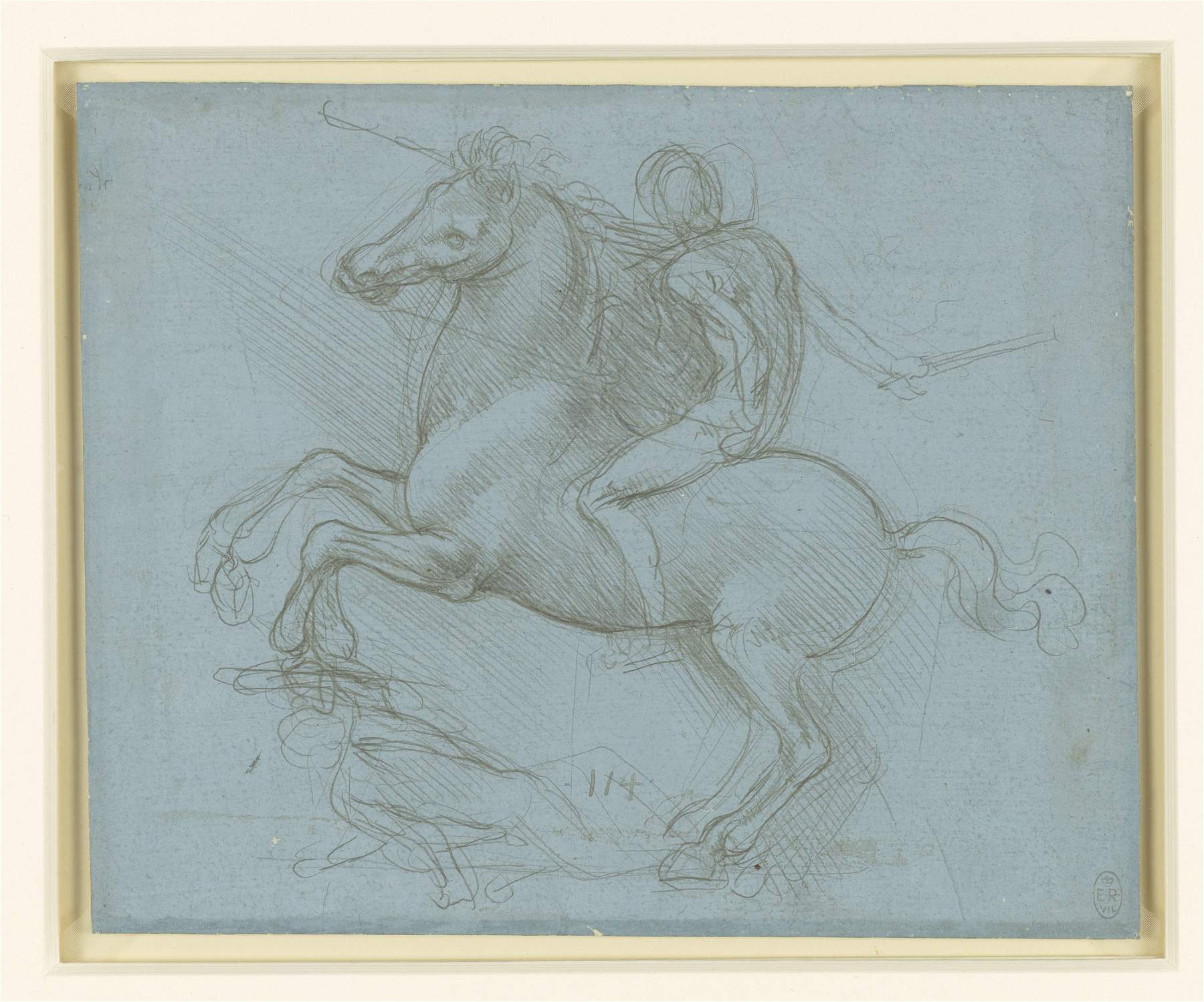 |
| Leonardo da Vinci, Study for Equestrian Monument (c. 1485-1490; metal point on blue prepared paper, 152 x 188 mm; Windsor, The Royal Collection, inv. 12358) |
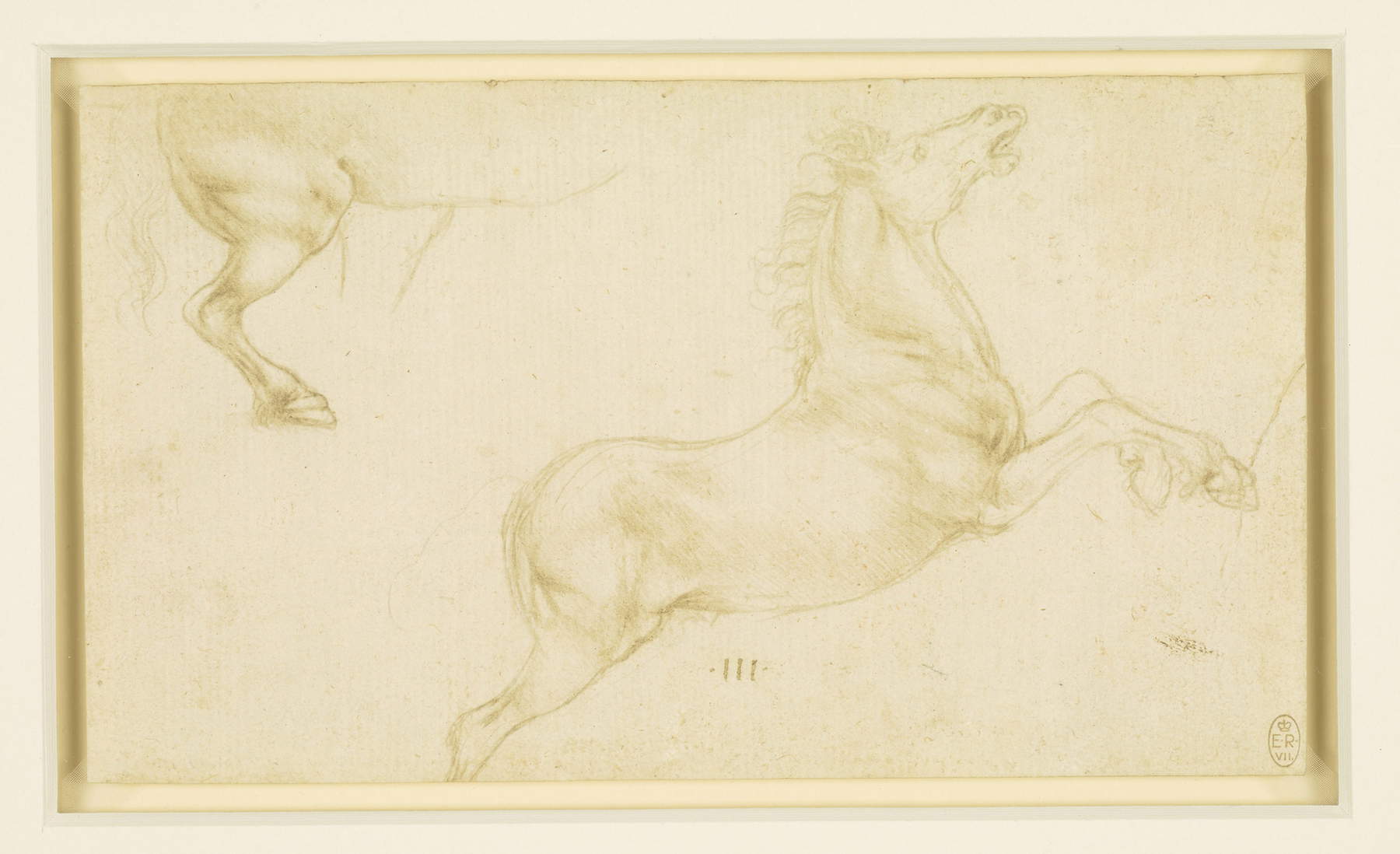 |
| Leonardo da Vinci, Study of a Horse (c. 1480; metallic point on rose-colored paper, 112 x 196 mm; Windsor, The Royal Collection, inv. 12315) |
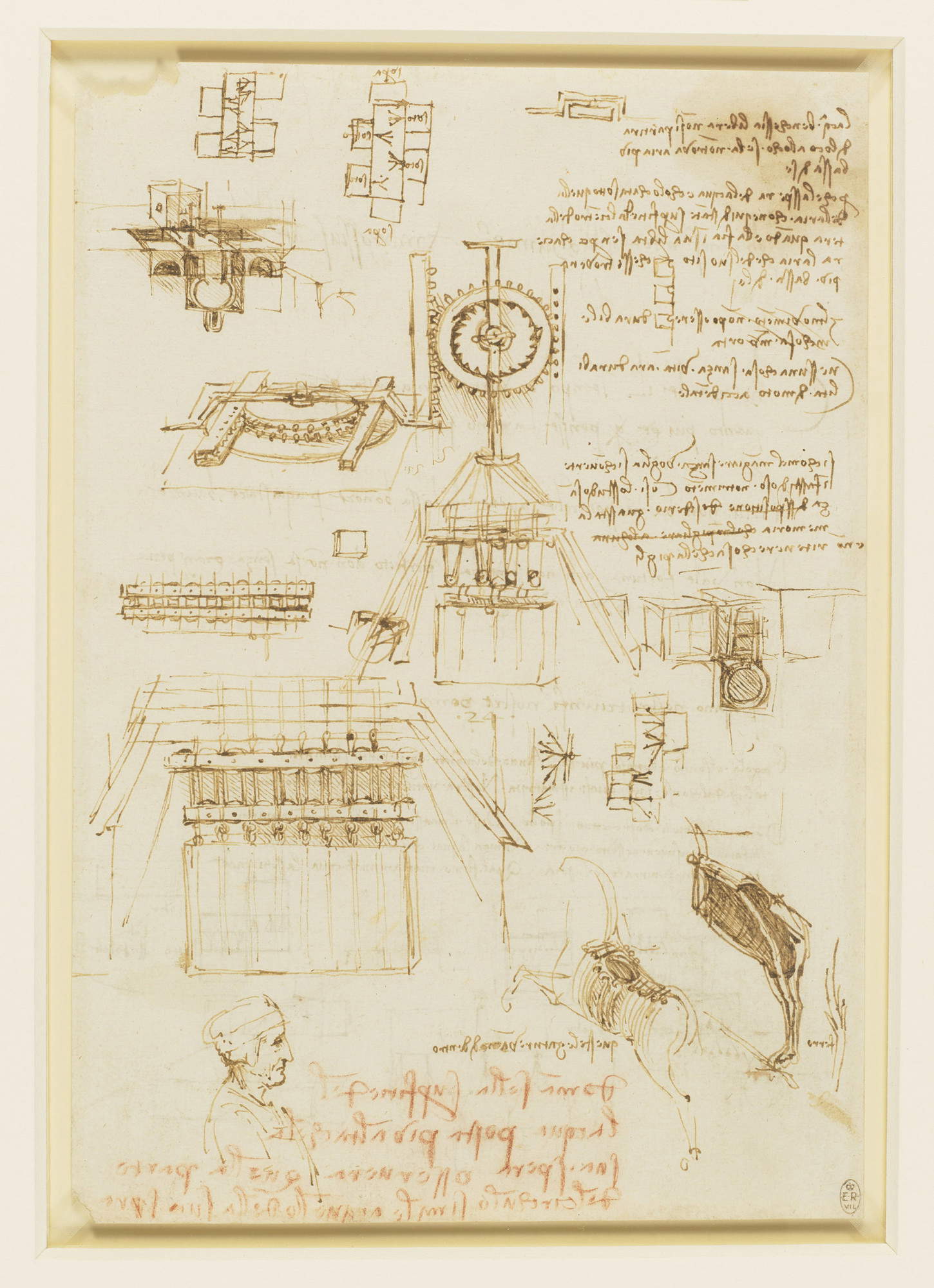 |
| Leonardo da Vinci, Studies for Casting the Monument to Francesco Sforza, Project I (c. 1490; pen and ink, 278 x 191 mm; Windsor, The Royal Collection, inv. 12351) |
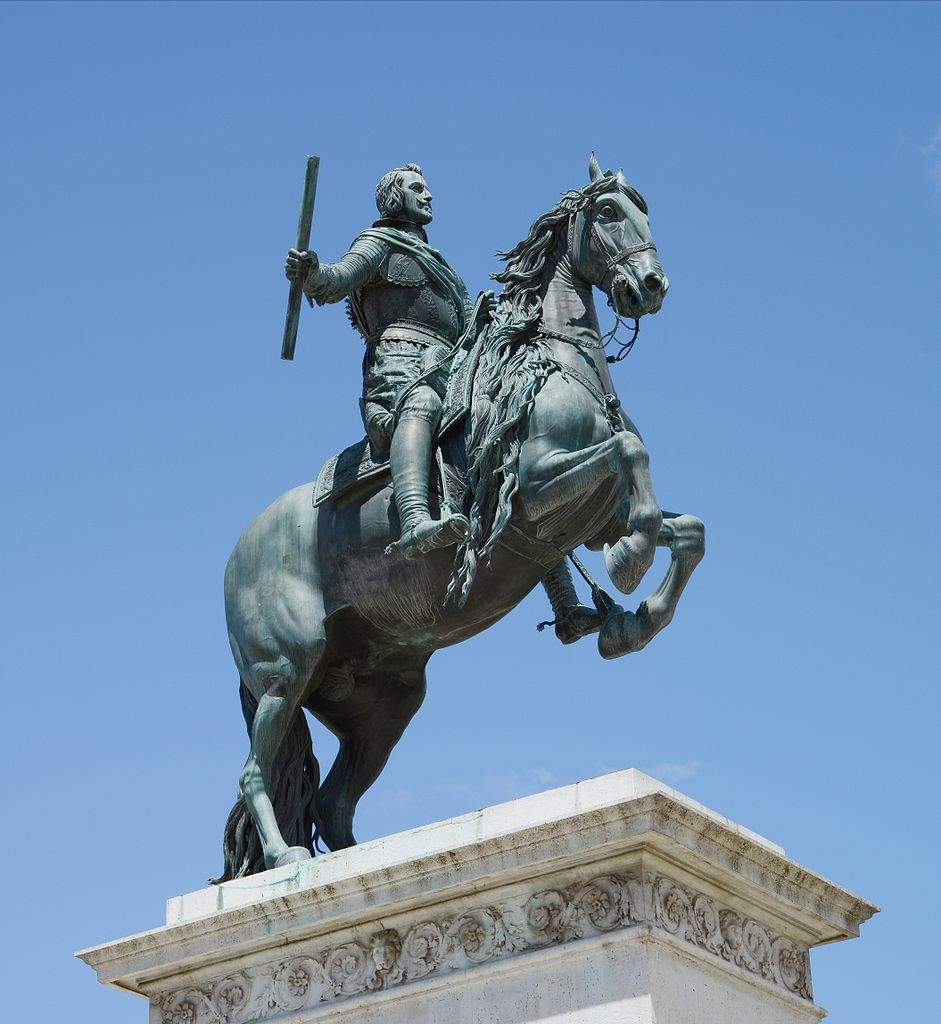 |
| Pietro Tacca, Monument to Philip IV of Spain (1634-1642; bronze; Madrid, Plaza de Oriente) |
Returning to Leonardo, between 1489 and 1490, the artist radically revisited his design, imagining a more traditional equestrian monument with the horse in step, similar to the equestrian monument of Marcus Aurelius in Rome. The artist would give glory to the Sforzas in another way: no longer through the boldness of the design, but through the monumental dimensions of the work (over seven meters, thus a height three times that of the first equestrian monument, weighing about 70 tons of bronze). For such an imposing work, the artist again had to reconsider the making technique. “In order to make the casting in a single casting,” we read again from Andrea Bernardoni, “it became necessary to devise an alternative method of an indirect type, which involved making the form in several separate sections to be assembled inside the casting pit. In developing this operational process, it is very likely that Leonardo had been inspired by the casting technique for artillery in which the construction of the casting mold in several sections was involved. In fact, we do not think it is a coincidence that it was during those years that Leonardo intensified his studies of firearms. The peculiarity of Leonardo’s method consisted in the use of the dowels used to cast the model, not only as matrices for the construction of the casting core, but also as an external counterform; the negative matrix, which in the traditional method was shaped directly on the surface of the wax model, was in this way rethought by transforming it into a complex recomposition of the dowels used for the cast, assembled with strong iron ligatures and plaster welds.” The different dowels were designed so that they would withstand the pressure of the molten bronze and prevent its spillage during casting. The form, once assembled, would then be completed with channels for casting.
Leonardo had already begun making the casting pit (horizontally, because the lay of the land in Milan did not allow the usual vertical design in the ground), but the political situation in Italy changed Ludovico il Moro’s requirements: in anticipation of Charles VIII’s descent into Italy (and the Duchy of Milan had joined the anti-French league of which the State of the Church, the Republic of Venice, the Empire, Spain and England were members), Ludovico il Moro was forced to allocate bronze to armaments and particularly to artillery. The situation did not change after the defeat of Charles VIII, as the war of succession of the Duchy of Milan would soon break out, sanctioning the fall of the Sforza family: the project was therefore abandoned.
 |
| Leonardo da Vinci, Casting Form of Horse’s Head (c. 1493; red chalk on paper, 210 x 300 mm; Madrid, Biblioteca Nacional, Madrid Codex 8936, f. 157v) |
 |
| Leonardo da Vinci, Foundry for the equestrian monument to Francesco Sforza (c. 1493; red chalk on paper, 210 x 300 mm; Madrid, Biblioteca Nacional, Madrid Codex 8936, f. 149v) |
However, the artist found himself only a few years later working on a new equestrian monument, the one for the monumental tomb of Gian Giacomo Trivulzio (Milan, 1440 - Arpajon, 1518), which the condottiero commissioned from Leonardo in 1506, when the Tuscan had a chance to return to Milan. Here again we know of several studies, where we note both the rearing horse on its hind legs and the traditional pacing horse. The Royal Collection also keeps a sheet with Leonardo’s notes for the casting: here we see the monument with the horse at the pass, and since there is already talk of casting it is conceivable that, in the end, the Vinci artist had settled for a more traditional iconography. The most advanced study is that of folio 12356 in the Royal Collection: here Leonardo, writes scholar Maria Teresa Fiorio, "reached the final solution: no longer the rearing horse, but the more classical position of the horse at pace [...] in line with modern interpretations of the equestrian monument by Donatello and Verrocchio. This typology, after all, had already been chosen for the colossal Sforza horse and gave greater guarantees of stability, although in the case of the Trivulzio monument the group was ’large in the natural’."
The design of the Trivulzio monument continued until 1511, but the undertaking was again blocked due to the changed political order: in 1512, in fact, the Sforza power was restored, and the pro-French Trivulzio, who, moreover, had been appointed Marshal of France in 1499 and had always remained loyal to King Francis I, was driven out of Milan. The circumstance therefore made it impossible to complete the project.
Not all of Leonardo’s legacy, however, was lost. The Museum of Fine Arts in Budapest today preserves a bronze statuette that, according to the interpretation of Pietro Cesare Marani, a leading Leonardo scholar, was made by Giovanni Francesco Rustici (Florence, 1475 Tours, 1554) in anticipation of the creation of an equestrian monument to Francis I of France: according to the information we get from Giovanni Paolo Lomazzo’s Treatise on the Art of Painting, Sculpture and Architecture, it seems in fact that Leonardo had passed on to Rustici some of his many studies on horses, and he probably also had the opportunity to talk with him about casting techniques (in 1508, Bernardoni points out, Leonardo da Vinci and Giovanni Francesco Rustici were staying together in the same house in Florence), and it is also conceivable that Francis I commissioned Rustici to make his monument precisely at Leonardo’s suggestion. Giorgio Vasari also speaks of the French commission to Rustici in his Lives: “It was given to make lately a bronze horse twice as large as the natural one over which the king was to be placed. There whence having put his hand to the work, after some models, which much pleased the king, he went on working the great model and the hollow to cast it in a great palace given him to enjoy by the king. But, since there was cause for it, the king died before the work was finished.” The completion of the work was, however, very troublesome: Rustici finished the monument only partially, and it was to be completed long afterwards by the sculptor Hubert Le Sueur (Paris, c. 1580 - 1658), who “converted” it into a monument to Henry I, Duke of Montmorency (the Montmorency family was the family that came into possession of Rustici’s unfinished horse). The work was later destroyed during the French Revolution.
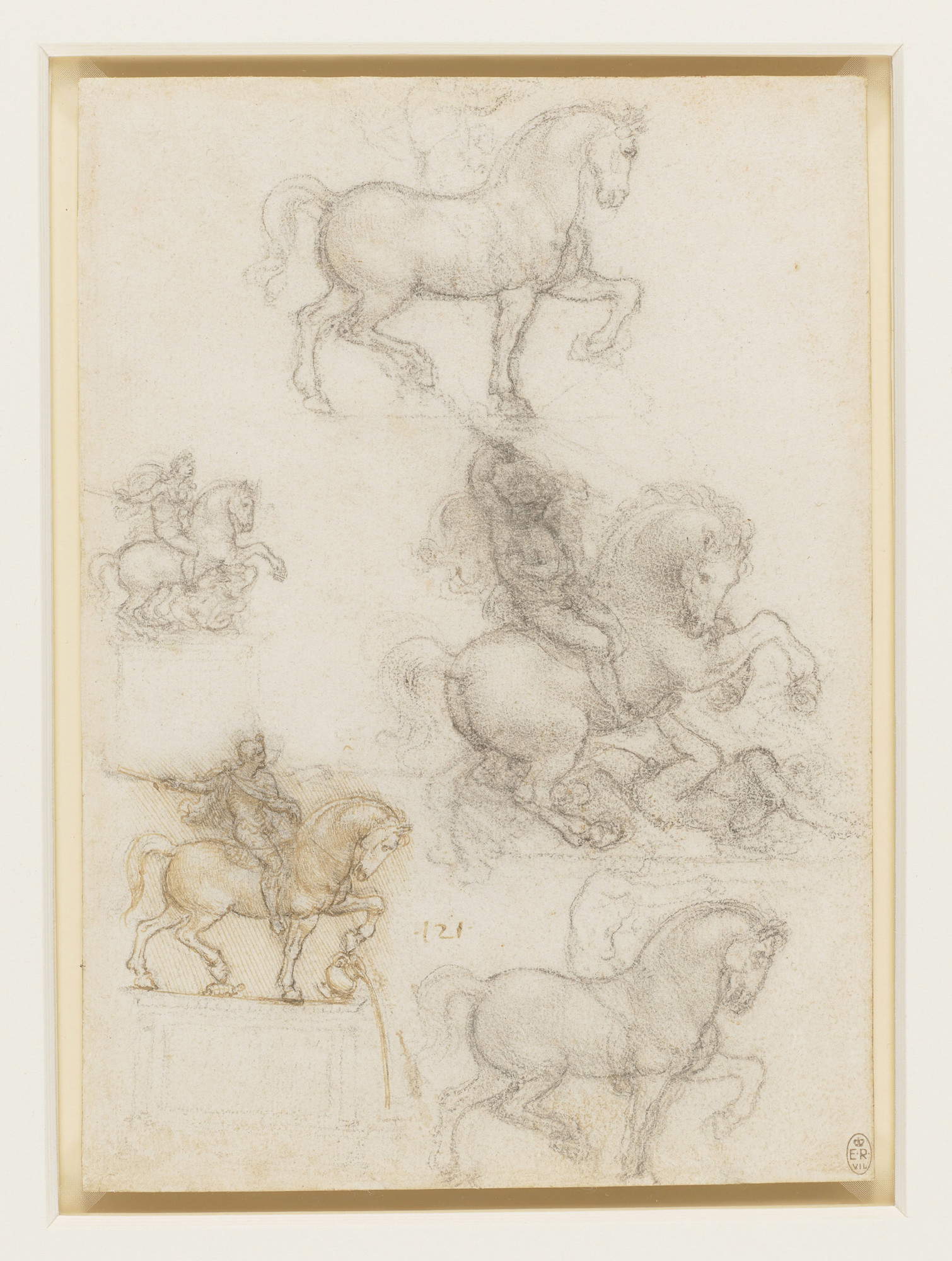 |
| Leonardo da Vinci, Studies for the Trivulzio Monument (c. 1506-1508; black chalk on paper, 224 x 160 mm; Windsor, The Royal Collection, inv. 12360) |
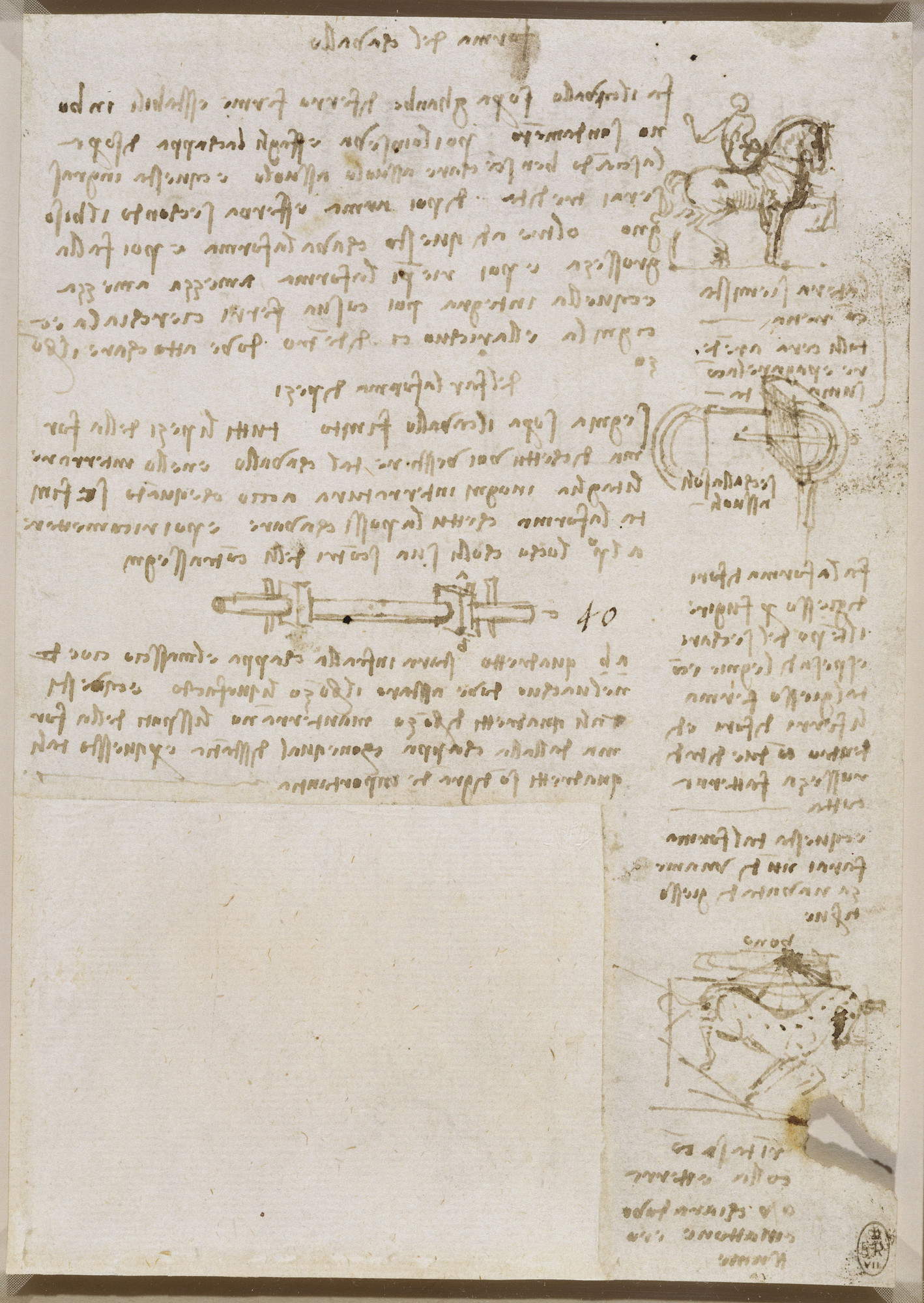 |
| Leonardo da Vinci, Studies for the casting of the Trivulzio monument (c. 1508-1510; black chalk on paper, 198 x 140 mm; Windsor, The Royal Collection, inv. 12347) |
 |
| Giovanni Francesco Rustici (?), Warrior on Horseback (early 16th century; bronze with green patina on wooden base, 24 x 15 x 28 cm; Budapest, Museum of Fine Arts) |
Then there is another, no less important Leonardian legacy: his studies of horses. Indeed, to design equestrian monuments, the artist had to study horses well and closely. In the Royal Collection, for example, is preserved a Study of the left profile of a horse (sheet number 12289 in the collection), with the front leg raised, in the typical position of horses depicted in step in equestrian monuments: for this reason, the drawing has been traced back to a study for a sculpture by several scholars such as Carlo Pedretti and Martin Kemp (it is even thought that the study in question reproduces an already existing statue, perhaps the famous Regisole of Pavia, the late antique statue of the Emperor Antoninus Pius, destroyed by the Jacobins of Pavia in 1796 and known from the drawings that artists drew from it: Leonardo had seen it in 1490 during a stay in Pavia with Francesco di Giorgio Martini). Of a different nature, on the other hand, is the sheet with Studies on the Front Legs of a Horse preserved in the Royal Library of Turin, in which the animal was studied from life, in a period that lies in the years immediately preceding 1490 (the latter being the year in which the artist is said to have abandoned the metal point technique). The drawing, Marani wrote, “shows Leonardo’s attention to capturing the effects of light on animal limbs, with the same subtlety and vibration that he reserves for the definition of the limbs of the human body, thanks to light, filamentous touches of white lead, reminiscent of the drawings of drapery on linen canvas of his early period, and demonstrating his desire to achieve sculptural effects.”
To the same period dates a Profile and Forehead of a Horse from the Royal Collection (inventory number 12321) in which, Bernardoni writes, Leonardo “achieves the result of a perfect balance between knowledge and impression, arriving at that ideal form which he was seeking through anatomical studies of this animal. The sense of volume given by the chiaroscuro conveys a metallic luster and smoothness that lead one to think that Leonardo had now reached the completion of the process of conceiving the horse for the Sforza monument and was preparing for the creation of the model, which, in this drawing, could thus find its first full visual expression.” There are also drawings that study the poses of the horse (produced not only in view of the equestrian monuments but also, for example, in the study phases of the Battle of Anghiari): again from the years before 1490, for example, dates a Prancing Horse from the Royal Library in Windsor.
 |
| Leonardo da Vinci, Study of the Left Profile of a Horse (c. 1490; metallic point, white lead on blue prepared paper, 85 x 147 mm; Windsor, The Royal Collection, inv. 12289r) |
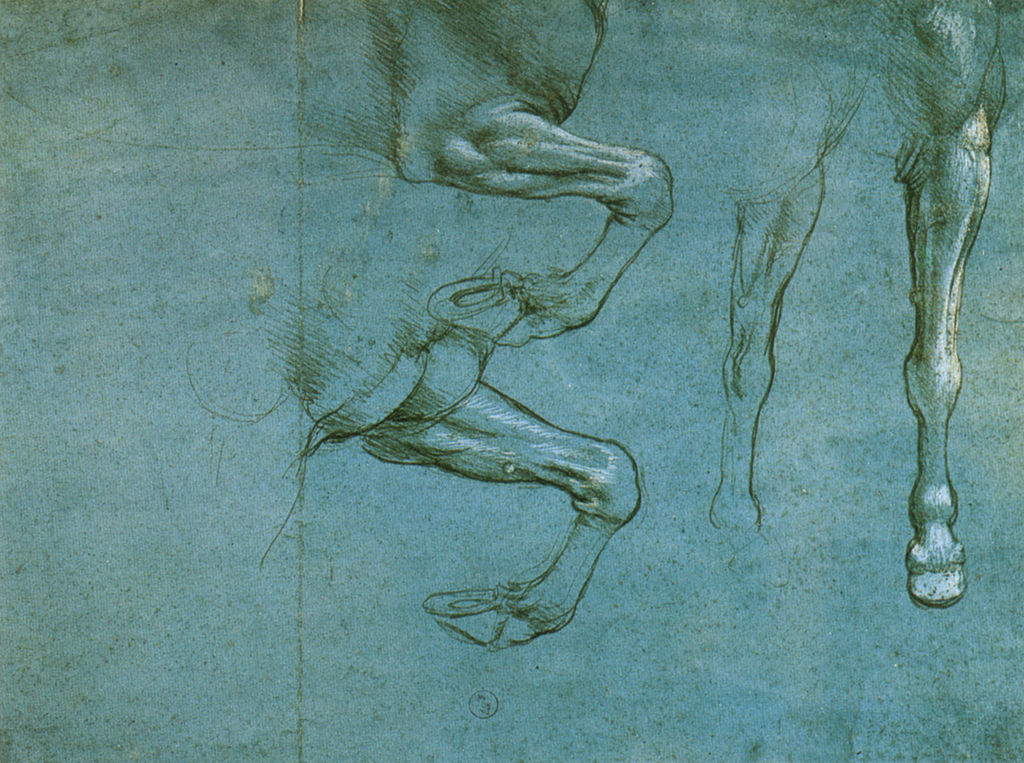 |
| Leonardo da Vinci, Study of the Front Legs of a Horse (c. 1488-1490; metallic point and white lead highlights on blue prepared paper, 154 x 205 mm; Turin, Royal Library, inv. 15580) |
 |
| Leonardo da Vinci, Profile and Forehead of Horse (c. 1490; metal point on blue prepared paper, 212 x 160 mm; Windsor, The Royal Collection, inv. 12321r) |
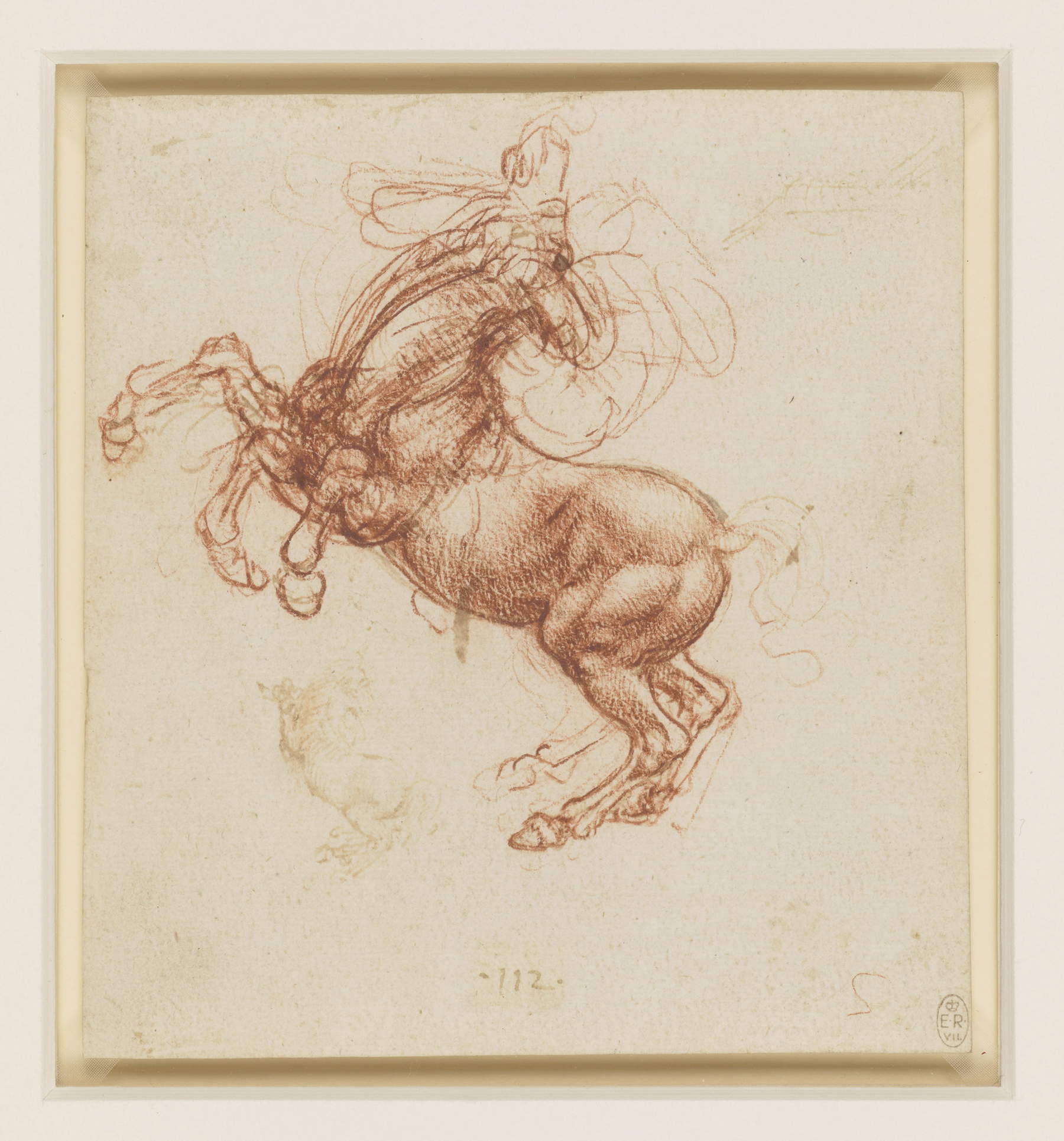 |
| Leonardo da Vinci, Prancing Horse (c. 1503-1504; red pencil, pen and ink, 153 x 142 mm; Windsor, The Royal Collection, inv. 912336) |
In practical terms, all of Leonardo’s designs for equestrian monuments (as noted, the two for the monument to Francesco Sforza and the one for the monument to Gian Giacomo Trivulzio) were destined to remain on paper. In contemporary times there were then more or less successful attempts to bring Leonardo’s ideas to life, with bronze castings taken from his drawings, but it is certainly in the ideas that the artist’s most interesting and relevant legacy should be identified, both in terms of studies on the work itself and the technical aspects related to its realization. In this case, however, the path begun by Leonardo in the 1580s could find a fulfillment precisely in the casting of Giovanni Francesco Rustici’s horse: later, when in 1699 the foundryman Jean Baltazar Keller made François Girardon’s enormous equestrian monument to Louis XIV (a work almost seven meters high), his methods, as Andrea Bernardoni has pointed out, manifested several similarities with those of Leonardo da Vinci.
Warning: the translation into English of the original Italian article was created using automatic tools. We undertake to review all articles, but we do not guarantee the total absence of inaccuracies in the translation due to the program. You can find the original by clicking on the ITA button. If you find any mistake,please contact us.